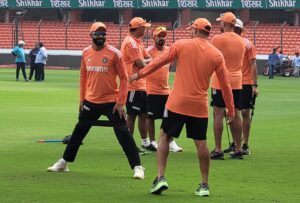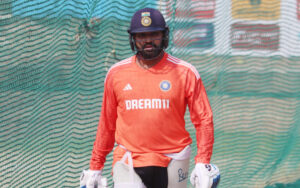
Over the last decade, for a visiting side, partaking in a Test series in India has seemed like navigating through a maze of never-to-be-solved jigsaw puzzle. So, can the Brendon McCullum and Ben Stokes-led England set-up usurp India in the forthcoming five-match Test series, starting in Hyderabad on January 25? What are the essential features of a successful template in such conditions? Let’s take a bird’s eye view on the blueprint required to win a Test rubber in India.
Finger spin/left-arm spin in demand
A couple of decades ago, left-arm spinners were regarded as more of a defensive option in Test cricket. But with DRS coming into play, left-arm spinners with certain attributes, are increasingly spearheading spin attacks in India or the subcontinent in general. In this era, the umpires are also ever-ready to adjudge a batter LBW, even if he or she takes a nice stride out. The simple reason is, with DRS around, the benefit of the doubt has gone out of the window. If in case the on-field umpire doesn’t answer the loud appeal in the affirmative, the spinner can avail for the DRS and look to overturn it.
Even the home side’s right-handed batters haven’t found it easy against left-arm spin in the recent past. In Asia, since the start of 2021, 69 right-handed batters from India have fallen victim to left-arm spin. In that period, even Virat Kohli and Rohit Sharma are averaging in low 20s against slow left-arm orthodox bowling in the Asian continent.
So, what are necessary skills needed for a slow left-arm orthodox bowler to pick up a rich haul of wickets in the subcontinent? One of them is to bowl quicker through the air and get it to skid. But it is also important to impart enough revs on the ball and get a few to turn, in order to sow the seeds of doubt in the batter’s mind. Ravindra Jadeja is the perfect bowler of this prototype. He has great control and lands it in the right areas more often than not. Some deliveries turn and a few others tend to go straight.
To make matters worse for a batter, there is no real discernible change in his grip. Steve Smith and Marnus Labuschagne, the Australian duo, had a taste of Jadeja’s tried and tested weaponry last year. India also have Axar Patel, whose offerings are more scrambled seam in nature. If anything, it just adds to his variations on a raging turner.
Obviously, England don’t have anyone in the class of Jadeja, Axar or R Ashwin. Jack Leach is an experienced left-arm spinner while Tom Hartley is his understudy. Perhaps England’s left-arm spinners need to just by heart Bishan Bedi’s golden words before going out to play. “On a turner, the most dangerous ball is the one that goes through straight.”
On a side note, not many leg-spinners from visiting sides have fared well in India. Even big names like Abdul Qadir and Shane Warne failed to make an impression. In fact, the two leg-spinners who have done well in India – Shahid Afridi and Richie Benaud – were quicker through the air.
For the Latest Sports News: Click Here
EXCLUSIVE: From playing tennis ball cricket to one of the mainstays of Indian pace attack, Md Siraj’s childhood coach recalls his inspiring journey. @debasissen @mdsirajofficial #INDvsENG #INDvENG #MdSiraj #IndianCricketTeam pic.twitter.com/cJOMJwojEQ
— RevSportz (@RevSportz) January 24, 2024
What about the fast-bowling tribe in Asia?
The fast bowlers also have a role to play in Asia. There is a theory that in Asia speed through the air is essential. To some extent that hypothesis holds true but there is more to it than just express pace. For periods of time, there would be little or no help on offer for fast bowlers. That is when a pace bowler has to don the role of being a support cast to the spinners and keep a lid on the scoring rate.
To illustrate the point further, Mohammed Shami, who is renowned for finding contrast swing, has bagged 76 wickets at an average of just 22.1 in India. But Shami has also ensured that he doesn’t leak runs from his end, evidenced by his rather healthy economy rate of around 3 in India. The 41-year-old James Anderson has aged like fine wine, especially when it comes to bowling in Asia.
Since the start of 2021, he has picked up 22 wickets at an astounding average of 14.59 in the subcontinent. It includes impactful spells in Galle, Chennai and Rawalpindi. His economy rate is also very impressive in that period as it stands at 1.96. Mark Wood, who will play as the lone seamer in the first Test because of his extra pace, also kept the runs down in Pakistan in 2022.
As a Test match progresses, the surfaces are expected to crumble and get abrasive in Asia. So, a pace bowler would look at old-ball swing – contrast or reverse swing – as an option. That is the right time for a pacer to up the ante and bowl at full tilt. Some bowlers also look to pull their length slightly back, with an eye on taking advantage of any kind of low bounce on offer. It is also pertinent to note that in Asia, a pace bowler has to shift his line slightly and zoom the ball on the stumps.
Teamwork
To generate swing with the old ball, it is crucial to keep it in good shape. And that point gains significance in the backdrop of ICC permanently banning use of saliva to shine the ball. So, teams have to find new methods. Just as an example, during the 2022 tour of Pakistan, England were using sweat and Leach’s bald head to shine.

Batting strategies
Will England’s ‘Bazball’ approach succeed against India’s potent spin trio? It is the question on every cricket fan’s lips. There is no harm in taking on the spin troika in testing conditions. But as good judges of the game would note that the batters also need to trust their defence.
With the DRS in existence, England’s batters also have to be slightly wary of thrusting their front pad out or committing too early on to the front foot. There is a school of thought that says expand your game against left-arm spinners by playing shots through covers and extra cover. It is also about protecting the inside-half of the bat by keeping out the straighter one. Ultimately, it comes down to picking the length early and playing late.
Kevin Pietersen, who cracked a superlative 186 in Mumbai during England’s tour of India in 2012-13, said to Times London: “If your feet are good, and you are not planting your front foot and you are playing down the line of the ball, you should be fine. Just make sure you are not getting bowled or LBW,” he noted. “It’s about learning not to commit yourself to the front foot; about waiting to pick the length of the ball, so you are not playing only with your hands. To do that, the drill is to hit any ball, wherever it pitches, through the off side,” he added.
Both set-ups would have done enough research on the finer points of the game when it comes to playing in India. The onus would be a lot more on the visiting England side to adapt to different climes. The hype surrounding their Bazball approach adds more intrigue to the Test series.
Also Read: Foakes ‘keeper, Bairstow specialist batter, confirms Stokes




